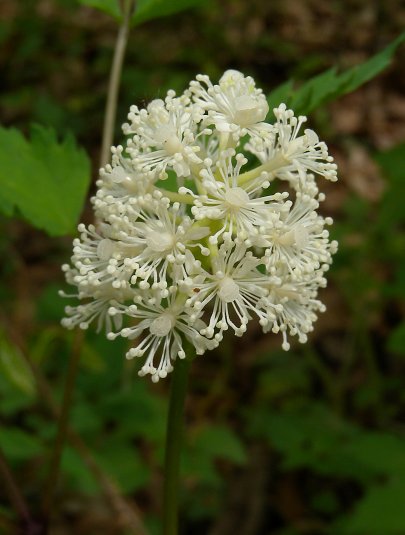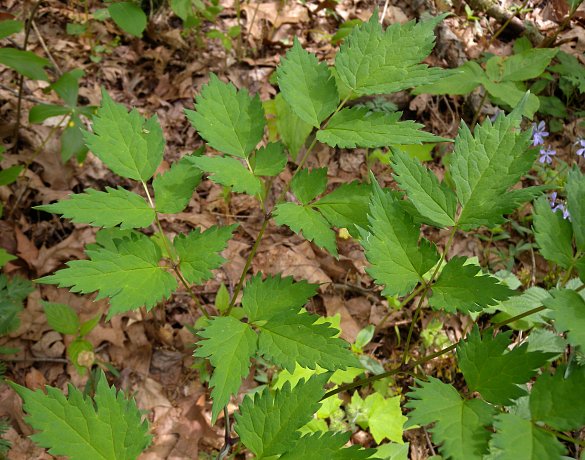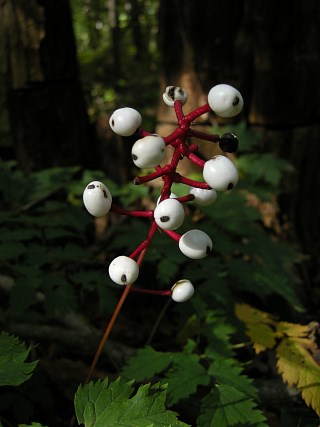Description: This perennial wildflower is 1–2½' tall and either unbranched or sparingly branched. The alternate compound leaves are 2- or 3-pinnate and large in size; the leaflets are organized into groups of 3 (less often 5). The lower compound leaves have long petioles, while the petioles of the upper compound leaves are shorter. The leaflets are up to 4" long and 2¼" across; they are more or less ovate in shape, while their margins are shallowly cleft and strongly toothed. Usually, the terminal leaflets are a little larger than the lateral leaflets; the terminal leaflets have slender petiolules (leaflet stalks), while the lateral leaflets are either sessile or they have slender petiolules. The upper surface of each leaflet is dull green and hairless; the lower surface is also hairless. A raceme of white flowers on a long naked peduncle develops from the axil of the uppermost compound leaf. Initially, this raceme is about 1½–3" long and short-cylindrical in shape, but it becomes longer (3-6") when its flowers are replaced with berries. Each raceme has 10-28 flowers on widely spreading pedicels; these pedicels are short (about ½"), glabrous, and stout.

Each flower spans
about ¼" across, consisting of 4-10 white petals, a dozen or more white
stamens, and a superior ovary with a short stout style. At the tip of
this style is a large persistent stigma that is translucent white
(although it later becomes dark). The sepals are early-deciduous and
insignificant. Each petal is narrowly oblanceolate and often truncate
at its tip. The blooming period occurs from late spring to very early
summer; it lasts about 2 weeks. The flowers are replaced by berries
that are ovoid-globoid and up to 1/3" (8 mm.) in length. These berries
become
bright white when they are mature, while the pedicels and central axis
of the raceme become bright red. At the outer end of each berry, there
is a dark spot from the persistent stigma. Inside each berry, there are
several seeds (fewer than 10). The root system is fibrous and
rhizomatous.
Cultivation:
Dappled sunlight to medium shade, moist to mesic conditions, and a
fertile loamy soil with abundant organic matter is preferred. The
compound leaves may become yellowish if they are exposed to excessive
sunlight.

Range &
Habitat:
The native Doll's Eyes is occasional throughout Illinois (see Distribution
Map). Habitats include rich deciduous woodlands, ravines,
thinly wooded bluffs, the bases of bluffs, and shaded seeps. This
species is found in high quality woodlands where the original ground
flora is intact.
Faunal Associations:
The flowers lack nectar and provide only pollen to visiting insects.
These visitors are mainly Halictid bees; Robertson (1929) observed Augochlorella
striata, Lasioglossum pectoralis, and Lasioglossum
zephyrus. Various birds eat the white berries to a limited
extent; this includes the Ruffed Grouse, Yellow-Bellied Sapsucker, and
American Robin (Eastman, 1992; pp. 12-13). These birds help to
distribute the seeds to a new areas. The White-Footed Mouse also eats
the berries. Because the foliage is toxic from a cardiac glycoside, it
is not eaten by mammalian herbivores. Other parts of this plant are
toxic as well, although birds are apparently immune to the toxic
effects of the berries. The overall value of this wildflower to
wildlife is low.

Photographic
Location:
Deciduous woodlands in east-central Illinois.
Comments:
This is one of many wonderful wildflowers that can be found in eastern
deciduous woodlands during the spring. Doll's Eyes has attractive
foliage and striking white berries, which become mature during the late
summer or early fall. These berries resemble the eyes of old-fashioned
china dolls, hence the common name. Another common name of this species
is White Baneberry, which refers to the appearance of the berries and
their toxic nature to humans. Another scientific name of this species
is Actaea alba. The other species in this genus, Actaea
rubra (Red Baneberry), is restricted to northern Illinois.
This latter species has red berries (usually) and the pedicels of its
flowers/berries are more slender than those of Doll's Eyes. Each berry
of Red Baneberry contains more seeds (10 or more) than a berry of
Doll's Eyes, and its seeds are smaller in size. However, there is an
uncommon form of Red Baneberry that produces white berries.